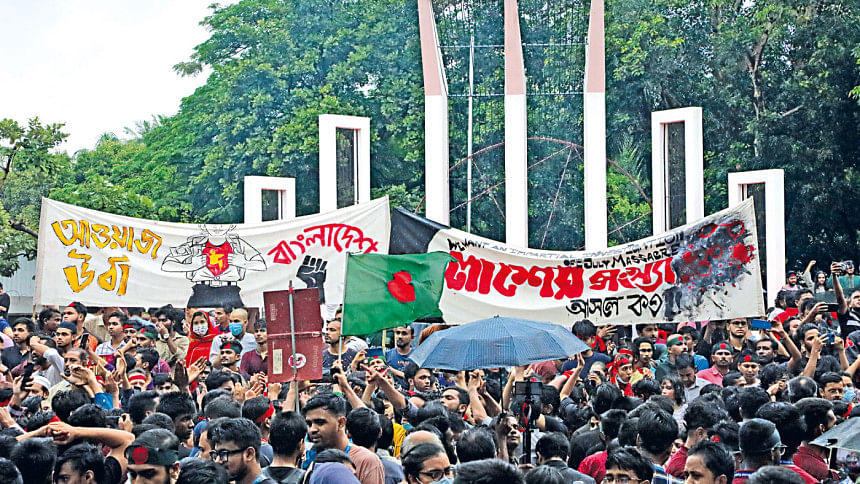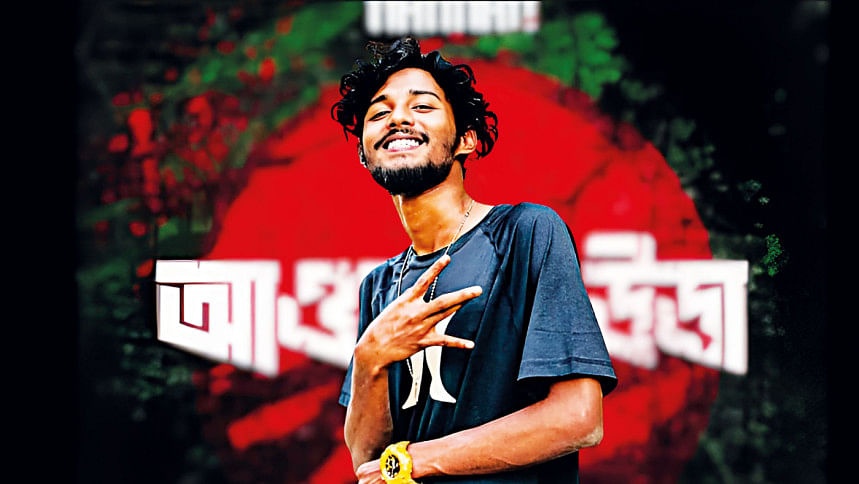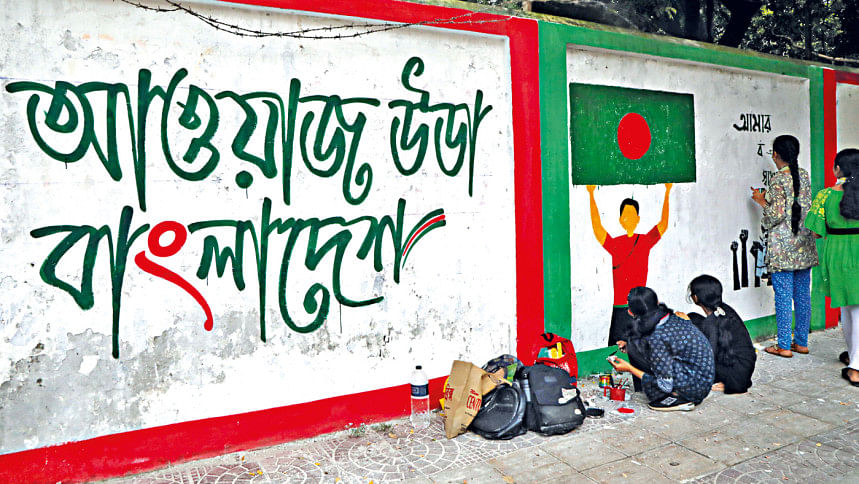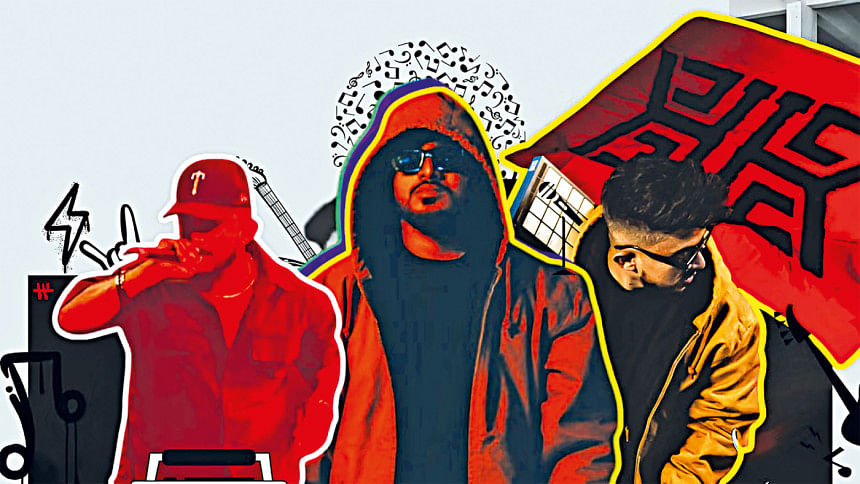Sound of the July uprising

While the July Uprising was sparked by economic problems, political repression, and a desire for democracy, it found a strong and surprising voice in a new form of music for Bangladesh: rap. Two songs, "Kotha Ko" (Speak Up) and "Awaz Utha" (Raise Your Voice), came to represent the sentiment of the movement in July. They captured the anger, frustration, hope, and defiance of a younger generation demanding change.
In earlier movements, like the one against General Ershad in 1990, traditional protest songs were key. Songs by Rabindranath Tagore (Rabindra Sangeet) and Kazi Nazrul Islam (Nazrul Geeti), which often talked about nationalism and rebellion, were widely performed. These movements utilised well-known and traditional cultural forms and were supported by established cultural groups, such as the Shammilito Shangskritik Jote and Udichi. They effectively provided the cultural justification for democracy, as people joined together in a mass uprising to end Ershad's decade-old military rule.
The 2013 Shahbagh movement, demanding punishment for war criminals, maintained similar cultural practices. Thousands of people would be singing Rabindra Sangeet and other patriotic songs throughout the day and night, demanding justice overdue since 1971. What started as a spontaneous protest—where a single invitation to come out to Shahbagh resulted in thousands and then hundreds of thousands joining—turned into a mass movement where people held ground for days on end. It was cultural practices of singing together and painting together, whether walls or streets, that sustained enthusiasm and solidarity, day in, day out.
Soon, and predictably, the Awami League government found it useful to co-opt it, insidiously introducing divisive politics into this supposed leaderless movement, given that the war criminals predominantly came from the Jamaat-e-Islami. The slogan "Tumi ke, ami ke, Bangali, Bangali" (Who are you, who am I? Bengali, Bengali!) became very popular, showing a shared national identity, but as progressives pointed out, it was exclusionary—excluding those not Bangali. Read cynically, it would also be a marker for those they would not consider to be Bangali—that is, the Islamists, whose support for the Jamaat-e-Islami could be interpreted as anti-national. Indeed, Islamists read it that way, in turn labelling the Shahbaghis—those protesting at Shahbagh—as atheists and anti-Islam. In turn, this became the justification to attack, even kill, writers and bloggers writing about the Shahbagh movement for being atheists. Clearly, the fractures that the Shahbagh movement revealed made way for violence, foretelling further identity-based violence to come.

The 2024 uprising was different in that it started fairly innocuously. The quota reform movement relied primarily on slogans and graffiti. Soon, the demands surrounding the protests shifted from a single issue (jobs) to multiple issues, ranging from reforms to democratic rights and anti-authoritarianism. Surprising older generations, the movement was dominated by the so-called complacent and indifferent Gen Z. They spoke a different language, it appeared—new words, new phrases, almost a new lexicon that combined abbreviations from both English and Bangla appeared on the walls. They spoke of inclusivity, of social justice.
Perhaps it is unsurprising that this new vernacular needed new music. The traditional Rabindra-Nazrul repertoire was insufficient—or so it seemed. No more generalised notions of anti-authoritarianism and people's will. Songs about ideal/utopian futures were out of vogue. Interestingly enough, artists who had been at the forefront of the cultural movements in 1990 and 2013 in favour of democracy and justice were missing this time. The belief that this was an Islamist takeover kept many of them silent, even in the face of state-sponsored killings, while others became fatalists and depressed.
Yet, the singing continued. "Muktiro Mondiro Shopano Tole Koto Pran Holo Bolidan," for example, became a favourite chorus, for its ability to speak to the pain of watching a friend die while also hoping that the sacrifice would mean something.
Rap songs appeared on social media like a bulldozer, speaking truth to power, as the cliché goes. These songs were powerful because of their specificity—documenting the injustices perpetrated by the state, listing the reasons why they no longer trusted the state. This appeared to be a generational shift, with younger Bangladeshis choosing a global style of music—one that was foreign to older generations—but still resonated with them because of the messages they conveyed. "Awaz Utha" and "Kotha Ko" can be seen as representative of the new-to-Bangladesh style of protest. Choosing rap showed a rejection of the old ways and a desire for a more direct way of speaking out.
"Awaz Utha" took an explicitly confrontational tone. The title, "Raise Your Voice," was a direct call to action. The lyrics include condemnation of state violence, references to specific incidents, emotive language, and explicit calls for revolution. The artist, Hannan, incorporated elements of Sheikh Mujibur Rahman's historic 7th March 1971 speech, including the call to "give more blood for freedom" and the iconic slogan "Joy Bangla." By reclaiming these symbols of the Liberation War, Hannan asserted that the spirit of 1971 and "Joy Bangla" belonged to the entire nation, not just the Awami League, as they claimed. This tied the 2024 movement to a broader narrative of Bangladeshi nationalism, challenging the ruling party's hegemonic control over historical memory.
"Kotha Ko," too, directly addressed the culture of silence. The title itself, "Speak Up," is a bold challenge. Using direct criticism of the government, colloquial language, and references to historical injustices, it calls for unity and action.
Thus emerged a new wave of protest music, complementing the traditional mould of collectively singing protest songs. Distinctively, these songs spread in a new way; they weren't sung in unison at protests or even at protest concerts. These were produced in small studios or at home and released directly online, with social media acting as the primary conduit. This was a decentralised, digital movement, very different from the past, where chorus music dominated protest.

Rap songs appeared on social media like a bulldozer, speaking truth to power, as the cliché goes. These songs were powerful because of their specificity—documenting the injustices perpetrated by the state, listing the reasons why they no longer trusted the state. This appeared to be a generational shift, with younger Bangladeshis choosing a global style of music—one that was foreign to older generations—but still resonated with them because of the messages they conveyed. "Awaz Utha" and "Kotha Ko" can be seen as representative of the new-to-Bangladesh style of protest.
This shift was epitomised by a burgeoning cohort of rappers and indie artists who channelled the anger, frustration, and aspirations of the student-led movement into powerful tracks. Platforms like YouTube and Facebook became the new protest stages, allowing for instant dissemination and circumventing traditional media gatekeepers. The comment sections of these online releases transformed into virtual gathering places for supporters, fostering a sense of community and shared purpose in a movement that was both physically on the streets and vibrantly alive in the digital realm. This organic, artist-led musical outpouring underscored the grassroots and tech-savvy nature of the July Movement.
The timing was critical too. These songs were all over social media just as the government lifted the internet blackout in late July. The songs seemed to consolidate all the angst and anguish of the week of information blackout amidst escalating state repression. They seemed to prove that people wouldn't be silenced. These were not famous artists—they became well-known because their songs captured the mood of the uprising and the times. They voiced the anger and hopes of a movement that was quickly changing from a complaint about job quotas to a demand for the government to step down.
This shift was further accentuated by a notable realignment within the cultural sphere. Many traditional artists and singers, long associated with secular and progressive movements, had, over time, become increasingly aligned with the Awami League government. This alignment, often driven by a perceived need for state patronage and a fear of rising Islamisation, led to a complex situation during the 2024 uprising. While some individual artists may have privately sympathised with the movement's goals, the established cultural organisations, traditionally at the forefront of protest, were largely silent or, in some cases, even implicitly supportive of the state's narrative. This perceived complicity with the increasingly authoritarian regime alienated them from the largely youth-led, digitally-driven protest movement. This created a vacuum—a void in the cultural landscape of resistance—that was swiftly filled by new voices, like the creators of "Kotha Ko" and "Awaz Utha", who were unburdened by ties to the existing power structure and unafraid to directly challenge the state's authority.
The traditional artists' fear of Islamisation, ironically, led them to support a regime that, through its actions, facilitated the conditions for a more polarised and volatile social environment, and enabled a silencing of voices. A year in, when emboldened Islamists speak of curtailing freedom, especially of women, we see the same people claiming the Awami League's repressive regime was better, instead of fighting for women's rights or progressive change in the present day—again participating in regressive politics through inaction.
But even as this new style of music emerged during the Uprising, a year in, we realise it might have been a momentary surge to meet the political urgency of the day. Other old habits, too, have continued. Protest slogans, for example, continue calls to "burn it down" ("agun jalo"). In a political climate where parties use fire as a weapon to mobilise support through fear—by burning down buses, for example—"agun jalo" becomes not only about lighting the fire in our hearts but also takes on a very literal meaning. In the wake of the July Uprising, the fact that homes were being burnt down—in fact, entire rows of homes—meant that slogans such as agun jalo are not only symbolic but literal.
Similarly, the continued demands for the death penalty ("fashi chai") show that anger and a desire for revenge are still part of Bangladeshi politics, with reforms still at the stage of rhetoric, despite the language of a "new" Bangladesh.

The Convenient Narrative of a "Rightist" Uprising
In the wake of the July Uprising, a narrative has emerged that seeks to portray the movement as a right-wing or Islamist conspiracy. This narrative has been promoted by both the remnants of the Awami League and by the right-wing groups themselves, as it serves their respective interests.
For the Awami League, this narrative is a way to delegitimise the protest movement and discredit its opponents. By framing the uprising as a "rightist" plot, the party can avoid acknowledging the genuine grievances that fuelled the protests, such as economic inequality, political repression, and the lack of democratic freedoms. It also allows the party to portray itself as a bulwark against religious extremism—a tactic it has used in the past to rally support both at home and abroad.
For the right-wing groups, the narrative of a "rightist" uprising is a way to exaggerate their own strength and influence. By taking credit for the downfall of the Hasina government, they can position themselves as the true voice of the opposition and attract new followers. This narrative also helps to obscure the fact that the uprising was a broad-based movement that brought together people from a wide range of political and ideological backgrounds.
The reality, of course, is that the July Uprising was a complex and multifaceted event that cannot be reduced to a simple narrative of left versus right or secularism versus Islamism. It was a spontaneous and largely leaderless movement that was driven by the anger and frustration of a generation that had been denied a voice for too long. The rap songs that became the anthems of the uprising are a testament to the power of culture to articulate the aspirations of a people and to challenge the structures of power.
Yet, we also know from history that such movements are susceptible to co-option. Just as the AL had co-opted the Shahbagh Movement, a whole slew of rightist political actors is now out to co-opt the July Uprising.
The future of Bangladesh remains uncertain. The country is at a crossroads, facing a host of challenges, including political instability, economic uncertainty, and rising religious and political polarisation. The July Uprising has opened up a space for new political possibilities, but it has also unleashed forces that could lead the country down a dangerous path. The challenge for the people of Bangladesh is to build a more inclusive and democratic society in which the voices of all citizens can be heard. The hundreds of thousands of people who took to the streets to protest state-sponsored killings—and the rappers of the July Uprising—have shown the way, demonstrating that even in the darkest of times, the human spirit can find a way to "speak up" and "raise its voice."
Dr Navine Murshid is a professor of political science and the author of India's Bangladesh Problem: The Marginalisation of Bengali Muslims in Neoliberal Times (Cambridge University Press, 2023) and The Politics of Refugees in South Asia (Routledge, 2013).

 For all latest news, follow The Daily Star's Google News channel.
For all latest news, follow The Daily Star's Google News channel. 



Comments